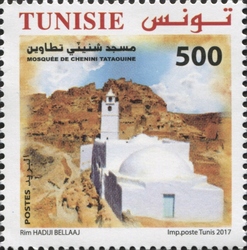Stamp: Religious Sites of Tunisia - Mosque Chenini Tatouine (Tunisia 2017)
Religious Sites of Tunisia - Mosque Chenini Tatouine (Tunisia 2017)
15 June (Tunisia ) within release Religious Sites of Tunisia goes into circulation Stamp Religious Sites of Tunisia - Mosque Chenini Tatouine face value 0.50 Tunisian dinar
| Stamp Religious Sites of Tunisia - Mosque Chenini Tatouine in catalogues | |
|---|---|
| WADP Numbering System - WNS: | WAD:TN009.17 |
Stamp is square format.
Number in set - 2||(show set). Layout - sheet of 40. Issuing - Office National des Postes Tunisie. Printer - Imprimerie des timbres-poste de la TunisieAlso in the issue Religious Sites of Tunisia :
- Stamp - Religious Sites of Tunisia - Mosque Sidi Bou Said Al Baji face value 0.50;
- Stamp - Religious Sites of Tunisia - Mosque Chenini Tatouine face value 0.50;
Stamp Religious Sites of Tunisia - Mosque Chenini Tatouine it reflects the thematic directions:
Architecture (Latin architectura, from the Greek ἀρχιτέκτων arkhitekton "architect", from ἀρχι- "chief" and τέκτων "builder") is both the process and the product of planning, designing, and constructing buildings and other physical structures. Architectural works, in the material form of buildings, are often perceived as cultural symbols and as works of art. Historical civilizations are often identified with their surviving architectural achievements.
Islam, lit. 'submission [to the will of God]') is an Abrahamic monotheistic religion centered on the Quran and the teachings of Muhammad, the religion's founder. Adherents of Islam are called Muslims, who are estimated to number approximately 1.9 billion worldwide and are the world's second-largest religious population after Christians
Classical antiquity, also known as the classical era, classical period, classical age, or simply antiquity, is the period of cultural European history between the 8th century BC and the 5th century AD. It comprises the interwoven civilizations of ancient Greece and Rome, known together as the Greco-Roman world, which played a major role in shaping the culture of the Mediterranean Basin. It is the period during which ancient Greece and Rome flourished and had major influence throughout much of Europe, North Africa, and West Asia. Classical antiquity was succeeded by the period now known as late antiquity.


